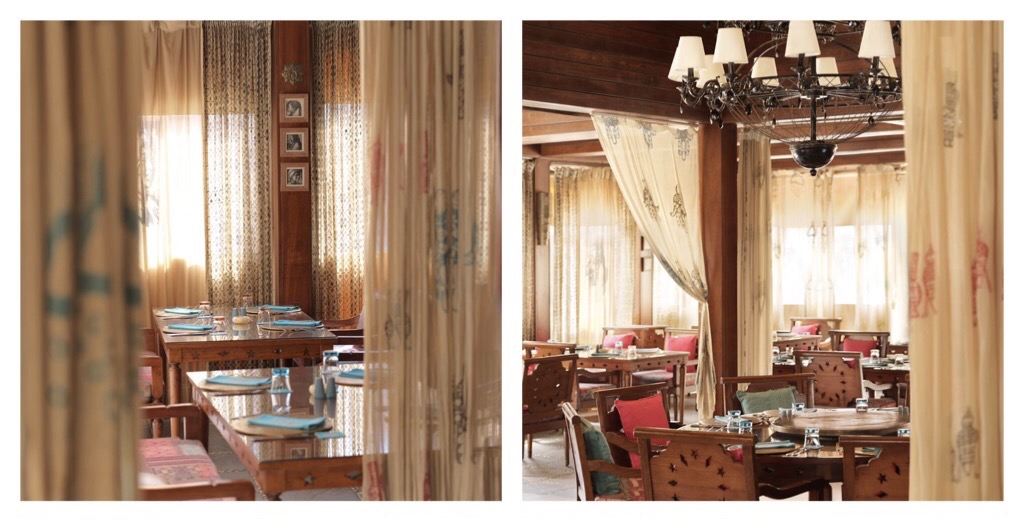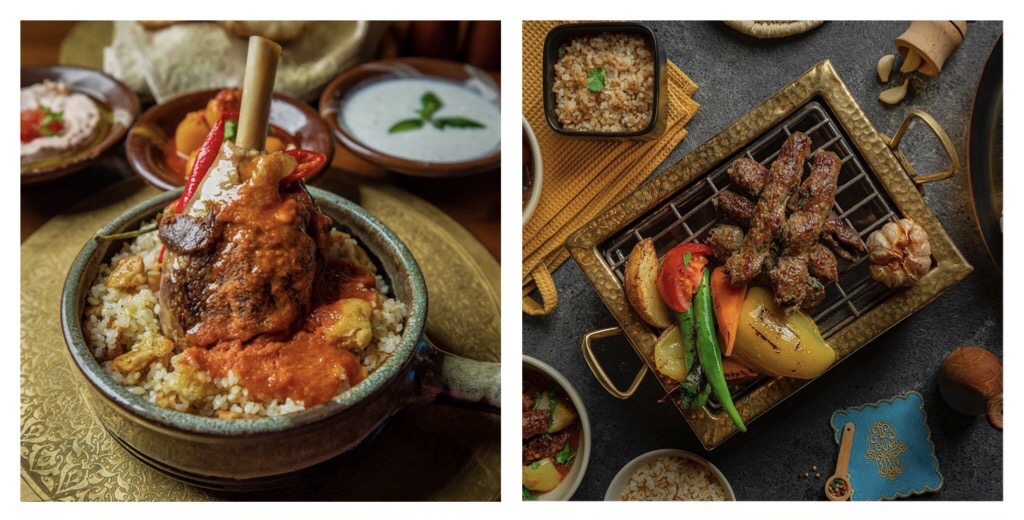Sampling local cuisine always ranks right up there alongside seeing the most famous sites and monuments when visiting a country as culturally rich as Egypt. Like many countries around the rim of the eastern Mediterranean, Egyptian food is a mixture of regionally inspired dishes combined with some very traditional local options that are uniquely native to Egypt. And the traditional Egyptian restaurant Al Khal, located in the poolside courtyard of the InterContinental Citystars, is one of the best places in Egypt to experience a genuine Egyptian meal in a 100% clean, sanitary, and trusted environment.
My biggest advice to tourists when it comes to food is to not be too adventurous or take risks when it comes to what you eat while you’re traveling. Most visitors to Egypt are only there for anywhere form 5-10 days, and a case of food poisoning from a sloppy street vendor or a careless cook at a hole-in-the-wall cafe could cost you two full days of your trip doubled over in your hotel room bed missing the sites you’ve waited a lifetime to come see.
Unlike in most cities around the world, I have always said that Egypt’s best restaurants of all varieties are located within its hotels, and this is especially the case in Cairo. I won’t get into all of the very good reasons for that here, but suffice it to say that after more than 18 years of experience living in and traveling to, from, and around Egypt literally more times than I can count, I’ve seen restaurants come and go and dined in everything from roadside stands to the finest establishments in the country. And now more than ever I still maintain that Egypt’s best restaurants and chefs take advantage of hotel real estate to set up shop and cook up authentic meals that delight diners’ senses.
Such is the case with Al Khal within the massive InterContinental Citystars hotel complex. The attention to detail in this restaurant is mind-blowing, starting with the first thing you notice when you approach it – the antique-looking flowing curtains encircling the space and separating it from the poolside courtyard area. They are made of 100% Egyptian cotton and are all painted using a lithography technique involving engraved black stones and a mixture of black tar that is transferred onto the cloth.

While this traditional technique may be too subtle a detail for most guests to notice, the scenes painted onto these fine fabrics surrounding the dining area may be recognizable to some history buffs, especially students and scholars of Egyptian history. They are scenes from Description de l’Égypte, the historically famous collection of observations of life in Egypt by the scholars and scientists who accompanied Napoleon on his expedition to Egypt from 1798-1801 and whose pages, when finally published in 1809, ignited a flurry of interest in visiting Egypt among aristocratic European audiences.
Once you’re seated among these billowing walls and have a chance to settle into Al Khal’s menu, you’ll begin to realize what I mean when I say that the offerings here are as traditional as they get in Egypt. Literally everything a lifelong Egyptian ate growing up and might be served when going home to their grandmother’s house, whether in a suburb of Cairo or a remote village in Upper Egypt or the Delta, can be found on the menu here alongside more beautiful colorized reproductions from Description de l’Égypte.
So let’s talk about a few of my favorite items, and then I’ll give you a suggestion for what else you should do to add one or two more special dishes to your table. First, while most of the dishes are sizable enough to share, what I like to do at places like this is order one or two things for myself – and let others know these are for me – and then either order more for the rest of the table or several more dishes that are deemed shareable. That’s because I have a few of my absolute favorite things that I like to eat when I’m at an Egyptian restaurant, and usually I’ve been craving them since the last time I left Egypt, so there are always one or two things I fully intend on eating an entire plate of myself before moving on to the shareables.
However, if this is your first time eating Egyptian food, you may not may not be as hungry as I usually am when I go here and may, therefore, want to adopt a full “family style” table full of shareable plates. Whichever way you like to and decide to go about it, you’ll enjoy it! Whatever floats your pharaonic boat.
Starting off, I like to spray the table with a variety of dippable salads and sauces. Without fail, I always start with a “salata baladi,” which translates to national salad in Arabic (you can just say baladi salad); a nice creamy garlicy tahini; zabadi, which is a delicious cucumber- and mint-flavored yogurt; a nice thick babaghaoug; and usually a delicious yellow lentil soup called ads. Now note that these are technically only the pre-appetizers, so you see why I’m saying there will be plenty of food to go around. But if I’m being honest, I still do order each one of these to taste even if it’s just me.
Next, the entire list of both hot and cold appetizers fill a page and a half of the menu. My favs are the gebna adima (cheese mixed with tomato and sesame paste); a coriander-infused lamb sausage called sougouk; rokak, which is dough stuffed with beef and onions; the foul beans with homemade falafel; and the stuffed and marinated vine leaves.
Ordering from those first few menu pages consisting of soups, salads, and hot and cold appetizers will be enough to get your started. Egyptian meals are meant to be enjoyed over a period of time, with lots of socializing, enjoying the music and ambiance, and having a drink or few along the way. Try ordering a hot tea to go with your first courses, and maybe an Egyptian beer or two as well. Stella (not Stella Artois, but Egyptian Stella) and Sakkara are the most popular brands of local beer, and I honestly like them and drink them a lot when I’m in Egypt.

Don’t get so carried away in the first round though that you forget to place your next order while you’re enjoying all of the starters. For main courses, this is where you’ll definitely want to order for the table and try a little bit of everything. Every time I go to any Egyptian restaurant, no matter how nice, I have to get an order of koshary. This is traditionally a very local street food, but even the really fancy Egyptian restaurants will still have it on the menu if they’re authentic. Al Khal of course does have it, and I always order a big bowl of it.
Another dish that is an absolute must for the table, especially at Al Khal, is molokheya. This is a very local and traditional green soup, but it is paired with various types of meat to make it into a main course as well. What’s really special about the molokheya at Al Khal is that it’s the only place in Egypt that I’ve ever seen them actually make it from scratch at your tableside. It’s literally going to be the freshest molokheya you’ll find anywhere in Egypt, and it’ll be your best opportunity to try this VERY Egyptian dish and know that it’s 100% fresh, clean, and delicious.

Then, have your pick of two dozen other main dish options loaded with succulent meats, local spices, warm sauces, and exotic flavors. Of the Egyptian-style tagens, which have their own page, the okra with lamb cubes is my favorite, with the stewed veal a close second. I love also getting a mixed grill for the table and picking the meats and vegetables out of that for my plate. And all of this is going to come with an endless supply of traditional Egyptian flat bread that is being cooked over in the corner of the restaurant by a lady on a open-air oven the exact same way they do in homes and villages throughout Egypt.
If all of this fills you up, then trust me – you need to take some time to relax, have another drink, digest a little, and let your stomach make some room for desert. Egyptians absolutely LOVE their sweets, and they make an enormous variety of local pastries, cakes, puddings, and other deserts that you really have to try while you’re here. I never care how full I am, but I will always order an om ali for desert, even if it’s just to smell it at the table. But trust me – I always find a way to eat some, and usually finish it. It’s just that good.
Konafa is another favorite desert of mine, although this is another time when I’d strongly recommend ordering several (or all, if you’re more than a few) of the deserts from the menu and try having a bite of them all. This is how meals are meant to be had in Egypt, and you’ll retire for the evening abundantly satisfied and agreeing that it was well worth it to have ventured into unexplored culinary territory while knowing that everything is good and perfectly safe to eat.
Now I just have one more suggestion that I always give to those who cannot be with me there personally or with a local to help guide them through the menu. Your waiter or waitress will certainly be Egyptian and will have grown up eating these foods for their entire lives. Ask what their favorite Egyptian foods are and try one or two things off of their own personal list too. Many Egyptians have the same favorites, and there’s a reason these dishes are SO popular among so many Egyptians – they’re classic, filling, and absolutely delicious.
As with the other Middle Eastern restaurants in the InterContinental Citystars, there is a reason you will see mostly Egyptians dining in these places alongside you, and that’s because they’re truly amazing and incredibly authentic. And for those same reasons, you also very well may run into me back there again myself very soon. A trip back to Egypt is never done right unless I have at least one night with an enormous spread of Egyptian food, and there is no better place to do it in Cairo than Al Khal.



